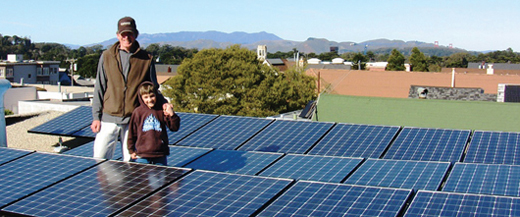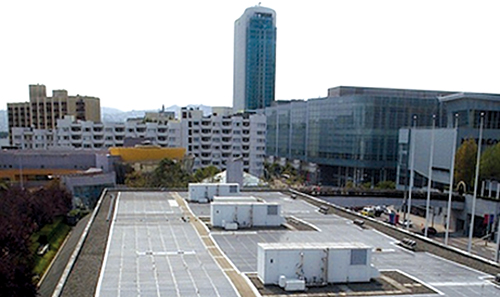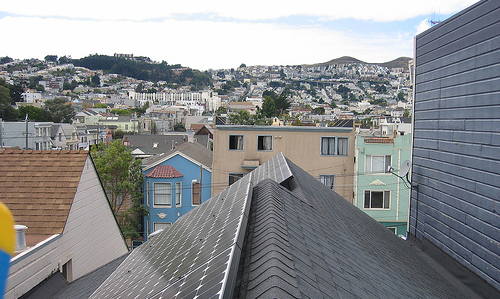Despite Americansí general acceptance of the reality of the climate change crisis, and their consequent acceptance of renewable sources of energy as a viable solution, advocates say that solar energyís mass application faces many of the same obstacles that it did thirty years ago.

More and more Bay Area residents are turning to the sun for their power needs and under the California Solar Initiative, the state currently offers rebates while the federal government offers tax credits for those who go solar. Photo courtesy of San Francisco Deptartment of the Environment
By Bill Picture
Published: June, 2008
One of those obstacles, according to Johanna Partin, Renewable Energy Program Manager for the San Francisco Department of the Environment, is misinformation. I get a lot of calls from people who want to know if solar is possible in San Francisco because of the fog, she says. And I tell them, ĎItís absolutely possible.í
Though San Francisco is famous for its fog-shrouded hills, the city actually enjoys more clear days each year than the world leader in solar energy production, Germany. In fact, the European nation gets 30 percent less direct sun annually than San Francisco. So if they can do it, we can do it, Partin adds.
Naturally, a solar-outfitted home in a foggier part of the city, such as the Sunset District, would produce less electricity than a home in, say, the Mission, which gets more direct sun. Still, solar experts say the Sunset District homeowner would save enough money on electricity each year to make the solar system worthwhile.
To help dispel the myth that solar energy isnít a feasible option in San Francisco, the San Francisco Department of the Environment and Denver-based CH2M Hill, a engineering, construction and operations firm, created the San Francisco Solar Map. The map shows all of the 750-plus existing solar projects in the city, at least a quarter of which are in neighborhoods east of Twin Peaks. The site also allows property owners to enter an address for an estimate of their propertyís solar potential. The site calculates the amount of solar energy produced annually, annual carbon savings and annual savings on utility-company-provided electricity, all based on the size of the propertyís rooftop.
The idea, Partin says, is to encourage more property owners to go solar by showing them that solar is already working for their neighbors.
Hopefully, someone will go to the site, see systems already installed in their neighborhood and go, ĎI want to do that, too.í
Minimizing the bureaucracy
To encourage more residential and commercial property owners to go solar,
David Hochschild of Fremont-based solar technology firm Solaria suggests that local governments reduce permit fees for solar installations and fast-track new construction projects that utilize solar technology.
Hochschild brought those suggestions to the table when he served on the San Francisco Solar Task Force, which was created to develop policies to promote solar energy use in San Francisco. His peers agreed. And San Francisco now offers one of the cheapest and least paper-heavy permitting processes for solar projects in the Bay Area.
The State of California currently offers a rebate to property owners who install solar systems, under the California Solar Initiative. And the federal government allows a tax credit, up to $2,000, to taxpayers who go solar. Still, Hochschild would like to see more monetary incentives. There just arenít enough incentives in place right now to make it attractive to most people, he says.
The San Francisco Solar Task Force drafted an ordinance to create a San Francisco Solar Incentive that would pay property owners between $3,000 and $10,000 per solar installation, depending on the size of their system. That ordinance was rejected by the Board of Supervisors; a revised ordinance goes before the Board again on June 7.
Yeah, but whatís it gonnaí
cost me?
Five years ago, only 12 percent of the sunlight captured by a solar cell was converted to energy. That number is now up to 15 percent, and continues to inch up each year. Todayís inverter, the mechanism that converts the DC (direct current) electricity produced by the solar cells to usable AC (alternate current) electricity is also more efficient. A few years ago, 30 percent of the DC electricity was lost in the inverter. That number is now down to 5 percent. These advances in solar technology are helping make solar more affordable for consumers. For the last thirty years, the cost of solar has decreased at an annual rate of 5 percent. A typical residential system now costs about $20,000.
But thatís no reason for consumers who are considering going solar to wait, according to JP Ross, Vice President of Strategic Relations at Berkeley-based solar installer Sungevity, who says the decrease in cost is also determined by volume: The more systems that are installed, the quicker the price comes down.
A lot of people still think of solar as a rich personís investment, he continues. But all you have to do is look at the numbers to see that itís really a smart personís investment. Take into account climate change, geopolitical instability and increasing electricity prices. And the benefits become clear really quickly.
Power in numbers
At present, there is no way for homeowners to pool their money, buy a system collectively and share the electricity it generates. For one thing, the technology that would allow the electricity to be divvied up and routed to multiple meters does not exist yet. But some enterprising homeowners have found a way to make solar more affordable for themselves.
In fall of 2007, Marin County resident Lisa Max and a few dozen of her solar-curious neighbors decided to form a united front. They formed GoSolarMarin and approached several solar installers collectively to inquire about a group discount. Several vendors submitted proposals, from which Novato-based SPG Solar was eventually selected as the groupís vendor of choice. And Max reports that more than 100 people have since taken SPG Solar up on its offer.
Similar groups in Portola Valley and Pacifica have done the same thing. And Max is considering forming her own consulting company to help other communities negotiate group discounts with solar installers. I want to help, because I really believe in the product, she says. I think the bulk purchase idea is an exciting way for communities to get some leverage, says JP Ross of Sungevity. The City of San Francisco is currently trying to identify groups within San Francisco that it can help to collectively negotiate with solar installers.
If we want to increase the number of installations in San Francisco, we need to bring the cost down, says Johanna Partin of the Cityís Department of the Environment. And this is a way to do that within the existing market.
Partin is also keeping a close eye on a pilot program created by the Sacramento Municipal Utility District. Under the program, SMUD customers, including renters and occupants of multi-unit buildings, will be able to invest in a large-scale solar system that feeds SMUDís grid and then purchase blocks of solar power back from SMUD at an affordable price.
The program could be a perfect fit for San Francisco, where rooftops are small. Even if it were possible to install a single system and split the power between multiple households, most rooftops in San Francisco arenít big enough to accommodate a system that can produce that much electricity. So weíre anxious to see how this works, Partin says.
The politics of solar
Current regulations that apply to solar projects tend to skew in the utility companiesí favor. And, the way that existing incentives are structured, property owners are encouraged to install undersize systems. But one State Assemblyman is hoping to change that.
Assemblyman Jared Huffman (D-San Rafael) coauthored a bill with Assemblyman Mark Leno (D-San Francisco) that would require the utility companies to pay the owners of solar systems for any excess electricity produced. Right now, that excess energy is fed into the utility companiesí grids; and the utility companies turn around and sell that electricity to customers at a profit. But they arenít required to reimburse the owner of the solar system that actually produced that electricity. Under AB1920, the utility companies would have to pay for that electricity. A fair price would be set by the California Public Utilities Commission.
One of the shortcomings of our solar incentives for the last few years, in my mind, has been that we donít offer sufficient upside for people who could be generating significant amounts of solar electricity, like businesses and schools that have big rooftops and parking lots, Huffman explains.
The bill is expected to be heard soon by the full Assembly. If it passes, the bill will then move on to the State Senate. All arrows point to solar, adds Huffman. And I think that we as legislators need to do what we can to encourage more people to go in that direction. Itís just good sound public policy.
Please visit these sites:
San Francisco Solar Map
Solaria www.solaria.com
Sungevity www.sungevity.com
GoSolarMarin www.sosolarmarin.org
GoSolarCalifornia

San Franciscoís Moscone Center has large arrays of solar panels installed on itís roof. Photo courtesy of San Francisco Deptartment of the Environment

Solar panels can work well even in area of the City that are frequently shrouded in fog. Photo courtesy of KQED

